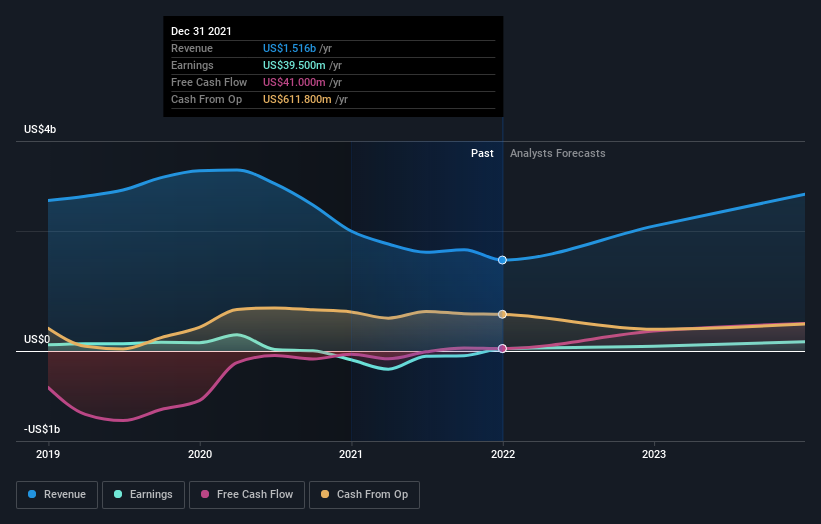- United States
- /
- Machinery
- /
- NYSE:TRN
Trinity Industries, Inc. (NYSE:TRN) Analysts Are More Bearish Than They Used To Be

The latest analyst coverage could presage a bad day for Trinity Industries, Inc. (NYSE:TRN), with the analysts making across-the-board cuts to their statutory estimates that might leave shareholders a little shell-shocked. Revenue and earnings per share (EPS) forecasts were both revised downwards, with analysts seeing grey clouds on the horizon.
Following the downgrade, the current consensus from Trinity Industries' four analysts is for revenues of US$2.1b in 2022 which - if met - would reflect a huge 37% increase on its sales over the past 12 months. Per-share earnings are expected to bounce 140% to US$0.97. Prior to this update, the analysts had been forecasting revenues of US$2.4b and earnings per share (EPS) of US$1.20 in 2022. It looks like analyst sentiment has declined substantially, with a measurable cut to revenue estimates and a considerable drop in earnings per share numbers as well.
View our latest analysis for Trinity Industries

Despite the cuts to forecast earnings, there was no real change to the US$35.75 price target, showing that the analysts don't think the changes have a meaningful impact on its intrinsic value. There's another way to think about price targets though, and that's to look at the range of price targets put forward by analysts, because a wide range of estimates could suggest a diverse view on possible outcomes for the business. There are some variant perceptions on Trinity Industries, with the most bullish analyst valuing it at US$38.00 and the most bearish at US$32.00 per share. Even so, with a relatively close grouping of estimates, it looks like the analysts are quite confident in their valuations, suggesting Trinity Industries is an easy business to forecast or the underlying assumptions are obvious.
One way to get more context on these forecasts is to look at how they compare to both past performance, and how other companies in the same industry are performing. One thing stands out from these estimates, which is that Trinity Industries is forecast to grow faster in the future than it has in the past, with revenues expected to display 37% annualised growth until the end of 2022. If achieved, this would be a much better result than the 13% annual decline over the past five years. Compare this against analyst estimates for the broader industry, which suggest that (in aggregate) industry revenues are expected to grow 7.4% annually. Not only are Trinity Industries' revenues expected to improve, it seems that the analysts are also expecting it to grow faster than the wider industry.
The Bottom Line
The biggest issue in the new estimates is that analysts have reduced their earnings per share estimates, suggesting business headwinds lay ahead for Trinity Industries. While analysts did downgrade their revenue estimates, these forecasts still imply revenues will perform better than the wider market. We're also surprised to see that the price target went unchanged. Still, deteriorating business conditions (assuming accurate forecasts!) can be a leading indicator for the stock price, so we wouldn't blame investors for being more cautious on Trinity Industries after the downgrade.
With that said, the long-term trajectory of the company's earnings is a lot more important than next year. We have estimates - from multiple Trinity Industries analysts - going out to 2023, and you can see them free on our platform here.
Another way to search for interesting companies that could be reaching an inflection point is to track whether management are buying or selling, with our free list of growing companies that insiders are buying.
Valuation is complex, but we're here to simplify it.
Discover if Trinity Industries might be undervalued or overvalued with our detailed analysis, featuring fair value estimates, potential risks, dividends, insider trades, and its financial condition.
Access Free AnalysisHave feedback on this article? Concerned about the content? Get in touch with us directly. Alternatively, email editorial-team (at) simplywallst.com.
This article by Simply Wall St is general in nature. We provide commentary based on historical data and analyst forecasts only using an unbiased methodology and our articles are not intended to be financial advice. It does not constitute a recommendation to buy or sell any stock, and does not take account of your objectives, or your financial situation. We aim to bring you long-term focused analysis driven by fundamental data. Note that our analysis may not factor in the latest price-sensitive company announcements or qualitative material. Simply Wall St has no position in any stocks mentioned.
About NYSE:TRN
Trinity Industries
Provides rail transportation products and services under the TrinityRail name in North America.
Good value with proven track record and pays a dividend.


